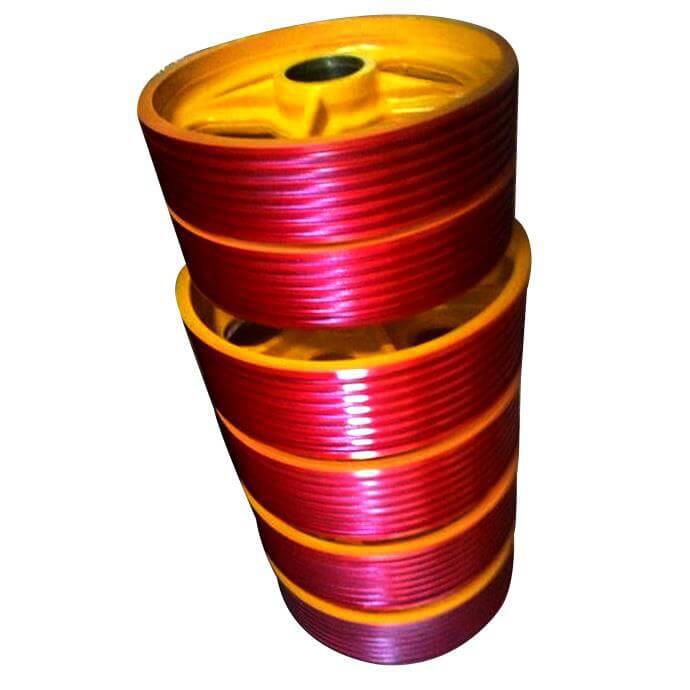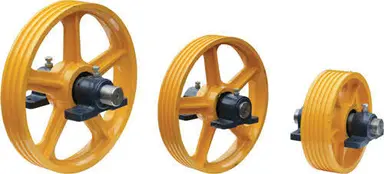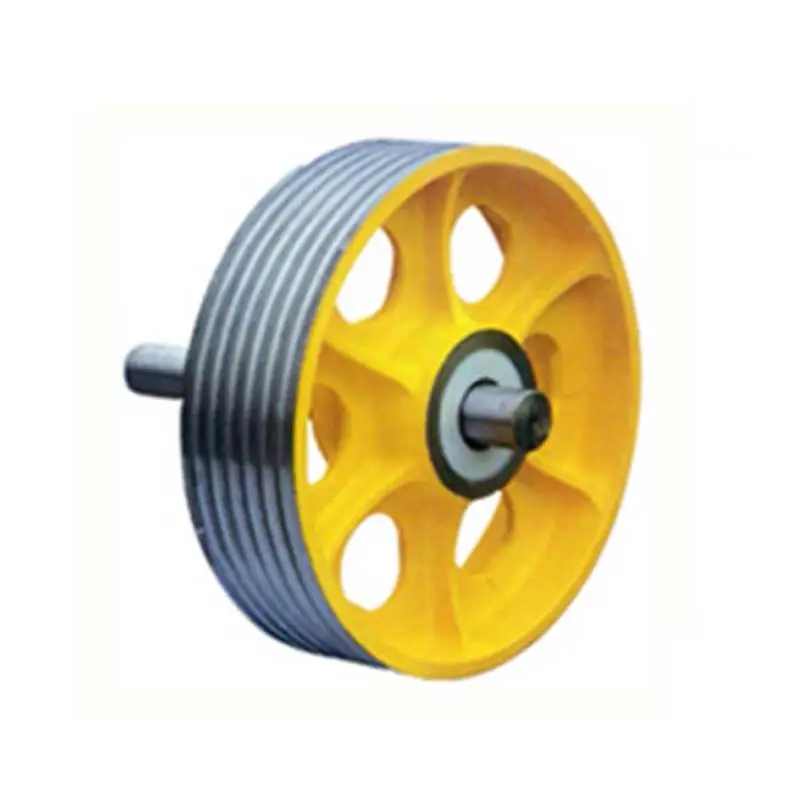Product Description
Product Description
Oval Eye Snatch Block Single Pulley for Lifting, K TYPE
Oval Eye Snatch Block Single Pulley is Widely Used in American, Asian as well as the Mid East. It is 1 kind of most popular Cable Pulley Block all over the world. The size is from 3″-18″. NOTE *Special marks can be made according to customers’ requirments. *Special package can be made according to customers’ requirements. *We also offer steel wire rope, wire rope thimble, wire rope sleeve, high quality Chains, connecting link, eye ling hook, eye self locking hook, master link, master link assembly, welded master link, welded master link assembly, CHINAMFG link, etc.
Product Parameters
Oval Eye Snatch Block Single Pulley for Lifting, K TYPE
| SIZE | CODE | S.W.L. | DIAM OF ROPE | QTY/CASE | N.W/G.W | WD SIZE |
| inch | ton | mm | pcs | kg | cm | |
| 5 | HYR12-5701 | 3 | 18~20 | 40 | 268/290 | 110x61x48 |
| 6 | HYR12-5702 | 5 | 20~22 | 40 | 464/474 | 114x66x54 |
Certifications
Packaging & Shipping
Payment Term
Exhibition
Our Factory
/* January 22, 2571 19:08:37 */!function(){function s(e,r){var a,o={};try{e&&e.split(“,”).forEach(function(e,t){e&&(a=e.match(/(.*?):(.*)$/))&&1
| Certification: | CE, ISO |
|---|---|
| Manufacturing Process: | Casting |
| Material: | Carbon Steel |
| Samples: |
US$ 50/Piece
1 Piece(Min.Order) | Order Sample |
|---|
| Customization: |
Available
| Customized Request |
|---|
.shipping-cost-tm .tm-status-off{background: none;padding:0;color: #1470cc}
|
Shipping Cost:
Estimated freight per unit. |
about shipping cost and estimated delivery time. |
|---|
| Payment Method: |
|
|---|---|
|
Initial Payment Full Payment |
| Currency: | US$ |
|---|
| Return&refunds: | You can apply for a refund up to 30 days after receipt of the products. |
|---|
What is the significance of compliance with safety standards when using lifting pulleys?
Compliance with safety standards is of utmost importance when using lifting pulleys. Adhering to safety standards ensures the well-being of workers, prevents accidents, and promotes a safe working environment. Here are the key reasons why compliance with safety standards is significant:
1. Worker Safety: Safety standards provide guidelines and regulations designed to protect workers from potential hazards associated with lifting operations. Compliance with these standards helps minimize the risk of accidents, injuries, and fatalities. By following safety procedures and using lifting pulleys in accordance with established standards, workers are less likely to be exposed to dangerous situations.
2. Risk Mitigation: Safety standards are developed based on extensive research, industry best practices, and lessons learned from past incidents. They address potential risks and provide specific measures to mitigate those risks. Compliance with safety standards reduces the likelihood of equipment failure, load instability, and other hazardous situations that can lead to accidents and injuries.
3. Legal and Regulatory Compliance: Many jurisdictions have specific safety regulations and standards that must be followed in lifting operations. Compliance with these legal requirements is essential to avoid penalties, fines, and legal liabilities. It also demonstrates a commitment to responsible and ethical business practices.
4. Industry Reputation: Compliance with safety standards enhances an organization’s reputation within the industry. It demonstrates a commitment to the well-being of workers and a dedication to maintaining high safety standards. Clients, partners, and stakeholders are more likely to trust and engage with companies that prioritize safety compliance.
5. Insurance and Liability: Non-compliance with safety standards may invalidate insurance coverage or result in higher insurance premiums. Insurance providers often require organizations to demonstrate compliance with safety regulations to ensure adequate risk management. Compliance with safety standards reduces the potential for accidents and liability claims, contributing to more favorable insurance terms.
6. Continuous Improvement: Safety standards are regularly updated to incorporate new knowledge, technologies, and industry trends. Compliance with these standards encourages organizations to stay current with the latest safety practices and continuously improve their lifting operations. It fosters a culture of safety awareness and encourages proactive measures to enhance safety and prevent incidents.
7. Effective Risk Assessment: Safety standards provide guidelines for conducting comprehensive risk assessments in lifting operations. Compliance ensures that potential hazards are identified, assessed, and managed effectively. It enables organizations to implement appropriate control measures, such as selecting the right lifting pulleys, using suitable lifting techniques, and providing necessary training and personal protective equipment.
8. Worker Empowerment: Compliance with safety standards empowers workers by providing them with a safe and secure environment to carry out their tasks. It promotes a safety-conscious culture and encourages workers to actively participate in safety programs, report hazards, and suggest improvements. When workers feel valued and protected, their morale, productivity, and overall well-being are positively impacted.
By complying with safety standards when using lifting pulleys, organizations prioritize the safety and welfare of their workers, mitigate risks, ensure legal compliance, enhance their reputation, and foster a culture of safety. It is a vital aspect of responsible and efficient lifting operations.
How do lifting pulleys enhance the safety and efficiency of lifting operations?
Lifting pulleys play a vital role in enhancing the safety and efficiency of lifting operations. They provide several advantages that contribute to safe and efficient lifting. Here’s how lifting pulleys enhance safety and efficiency:
1. Mechanical Advantage: Lifting pulleys provide a mechanical advantage by distributing the load’s weight across multiple sheaves or blocks. This distribution reduces the amount of force required to lift the load, making it easier for operators to handle heavy objects. The mechanical advantage offered by lifting pulleys minimizes the risk of strain or fatigue-related injuries to operators, promoting safe lifting practices.
2. Load Distribution: By utilizing lifting pulleys, the load’s weight is distributed among multiple strands of lifting cables or ropes. This distribution helps to evenly spread the load’s force, reducing the risk of overload on any single point or component. Load distribution minimizes the chances of cable or rope failure, ensuring safe lifting and preventing accidents due to sudden load shifts or unbalanced loads.
3. Controlled Movement: Lifting pulleys enable precise and controlled movement of the load. The pulleys allow operators to adjust the lifting speed, direction, and position of the load with ease. This control enhances safety by preventing sudden or jarring movements that can lead to accidents or damage to the lifted objects. It also allows for accurate placement or positioning of the load, improving operational efficiency.
4. Reduced Friction: Lifting pulleys are designed to reduce friction between the lifting cables or ropes and the pulley sheaves. This reduction in friction minimizes wear and tear on the lifting components, such as cables or ropes, extending their lifespan and reducing the risk of failure during lifting operations. It also reduces the effort required to lift the load, improving efficiency and operator comfort.
5. Versatility and Adaptability: Lifting pulleys offer versatility and adaptability in various lifting scenarios. They can be combined with other pulleys or lifting systems to create compound mechanical advantages, such as block and tackle systems. This flexibility allows operators to handle different load capacities and adapt to specific lifting requirements. Versatility and adaptability enhance the efficiency of lifting operations by providing suitable solutions for a wide range of lifting tasks.
6. Safe Working Load Indication: Many lifting pulleys come with clearly marked safe working load (SWL) indications. These markings provide crucial information about the maximum load capacity that the pulley can safely handle. By adhering to the SWL guidelines, operators can ensure that the pulleys are not overloaded, reducing the risk of accidents and equipment failures.
7. Training and Operator Awareness: Proper training and operator awareness regarding the use of lifting pulleys contribute to safe and efficient lifting operations. Operators should receive training on the correct techniques for operating and maintaining lifting pulleys. They should also be aware of safety protocols, load limits, and the importance of regular inspections and maintenance procedures. Well-trained operators can make informed decisions, identify potential hazards, and implement safe work practices, further enhancing the safety and efficiency of lifting operations.
By utilizing lifting pulleys, operators can benefit from improved safety and efficiency in lifting operations. The mechanical advantage, load distribution, controlled movement, reduced friction, versatility, and operator training all contribute to safer lifting practices, reduced risk of accidents, and increased operational efficiency.
What is a lifting pulley, and how is it used in various lifting applications?
A lifting pulley is a mechanical device used to change the direction of a lifting force and facilitate the lifting or lowering of heavy objects. It consists of a grooved wheel or sheave that rotates on an axle and is typically mounted on a frame or housing. Here’s an explanation of how lifting pulleys are used in various lifting applications:
1. Block and Tackle Systems: Lifting pulleys are commonly used in block and tackle systems, which utilize multiple pulleys to create a mechanical advantage. By arranging the pulleys in a specific configuration, such as a fixed pulley and a movable pulley, block and tackle systems allow users to lift heavy loads with less effort. Lifting pulleys in block and tackle systems distribute the load across multiple ropes, reducing the force required to lift the load.
2. Crane and Hoist Systems: Lifting pulleys are integral components of cranes and hoists used in construction, manufacturing, and other industries. In these systems, the pulleys are part of the lifting mechanism and are responsible for raising and lowering heavy loads. The pulleys in crane and hoist systems provide the necessary mechanical advantage to lift heavy objects safely and efficiently.
3. Elevator Systems: Elevators rely on lifting pulleys to move the elevator car up and down. The pulleys, along with the elevator cables or ropes, form the traction system that lifts and lowers the car. The pulleys in elevator systems ensure smooth and controlled movement while distributing the load evenly across the cables, allowing for safe transportation of passengers or goods.
4. Rigging and Rigging Gear: Lifting pulleys are often used in rigging applications, such as in the construction or entertainment industry. They are employed to redirect the lifting force, change the direction of the load, or create lifting configurations suitable for specific tasks. Lifting pulleys used in rigging applications are designed to withstand heavy loads and provide reliable lifting capabilities.
5. Material Handling Equipment: Lifting pulleys are utilized in various material handling equipment, including winches, come-alongs, and manual chain hoists. These devices incorporate pulleys to facilitate the lifting and transportation of heavy objects. Lifting pulleys in material handling equipment enable operators to apply force in the desired direction, making it easier to handle and move heavy loads.
6. Sailing and Boating: Lifting pulleys, also known as blocks, are extensively used in sailing and boating applications. They are employed to control and adjust the tension in ropes and lines, such as halyards and sheets. Lifting pulleys in sailing and boating enhance the efficiency of sail handling, allowing sailors to hoist, lower, and trim sails with ease.
Lifting pulleys are versatile devices that find application in a wide range of lifting scenarios. Whether in block and tackle systems, crane and hoist systems, elevator systems, rigging, material handling equipment, or sailing and boating, lifting pulleys play a crucial role in facilitating safe and efficient lifting operations.
editor by CX
2024-03-27




